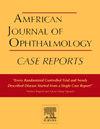Successful treatment of glaucoma in Sturge–Weber syndrome using PreserFlo™ microshunt with intraluminal stenting: a case report
Q3 Medicine
引用次数: 0
Abstract
Purpose
We report a case of glaucoma associated with Sturge–Weber syndrome (SWS) that was successfully managed with PreserFlo™ microshunt (PFM) insertion combined with two intraluminal 10-0 nylon suture stents.
Observations
A 27-year-old female patient with SWS and persistently elevated intraocular pressure (IOP) in the right eye was referred to our hospital for surgical treatment. The patient was diagnosed with bilateral SWS-related glaucoma. She first underwent a right trabeculotomy at the age of 11, followed by a trabeculectomy on the same eye. At the age of 13, a trabeculectomy was performed on the left eye. At the time of presentation, her right eye IOP was 28 mmHg. A PFM with two 10-0 nylon intraluminal sutures was implanted. On postoperative day 1, IOP decreased to 16 mmHg. The shunt was well positioned without complications. On day 17, IOP rose to 20 mmHg, leading to the removal of one suture. On day 22, IOP dropped to 18 mmHg, and the second suture was removed.
Conclusions
Herein, we successfully executed PFM insertion with intraluminal stenting in a patient with SWS, resulting in effective IOP reduction without any serious postoperative complications. These findings suggest that PFM insertion with stenting could be a viable treatment option for glaucoma associated with SWS.
PreserFlo™微分流器联合腔内支架成功治疗斯特奇-韦伯综合征青光眼1例
目的:我们报告一例伴有斯特格-韦伯综合征(SWS)的青光眼患者,通过PreserFlo™微分流器(PFM)置入联合两个腔内10-0尼龙缝合支架成功治疗。观察1例27岁女性SWS伴右眼持续高眼压(IOP)至我院行手术治疗。患者被诊断为双侧sws相关性青光眼。11岁时,她第一次接受了右眼小梁切开术,随后又在同一只眼睛上进行了小梁切除术。13岁时,左眼行小梁切除术。在就诊时,右眼IOP为28 mmHg。植入带两个10-0尼龙腔内缝合线的PFM。术后第1天,IOP降至16 mmHg。分流器定位良好,无并发症。第17天,IOP上升至20 mmHg,导致拆除一根缝合线。第22天,IOP降至18 mmHg,并拆除第二次缝线。结论我们成功实施了一例SWS患者PFM置入腔内支架,有效降低了IOP,无严重的术后并发症。这些发现表明PFM植入支架可能是SWS相关性青光眼的一种可行的治疗选择。
本文章由计算机程序翻译,如有差异,请以英文原文为准。
求助全文
约1分钟内获得全文
求助全文
来源期刊

American Journal of Ophthalmology Case Reports
Medicine-Ophthalmology
CiteScore
2.40
自引率
0.00%
发文量
513
审稿时长
16 weeks
期刊介绍:
The American Journal of Ophthalmology Case Reports is a peer-reviewed, scientific publication that welcomes the submission of original, previously unpublished case report manuscripts directed to ophthalmologists and visual science specialists. The cases shall be challenging and stimulating but shall also be presented in an educational format to engage the readers as if they are working alongside with the caring clinician scientists to manage the patients. Submissions shall be clear, concise, and well-documented reports. Brief reports and case series submissions on specific themes are also very welcome.
 求助内容:
求助内容: 应助结果提醒方式:
应助结果提醒方式:


